This is an old revision of this page, as edited by 102.223.58.133 (talk) at 08:46, 15 September 2024 (→Spain). The present address (URL) is a permanent link to this revision, which may differ significantly from the current revision.
Revision as of 08:46, 15 September 2024 by 102.223.58.133 (talk) (→Spain)(diff) ← Previous revision | Latest revision (diff) | Newer revision → (diff)This article has multiple issues. Please help improve it or discuss these issues on the talk page. (Learn how and when to remove these messages)
|
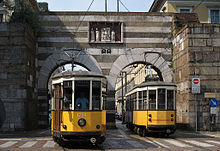
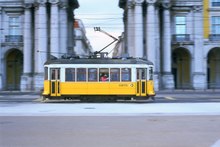
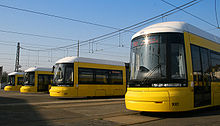
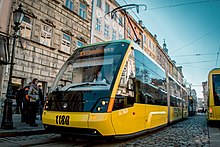
Europe has an extensive number of tramway networks. Some of these networks have been upgraded to light rail standards, called Stadtbahn in Germany, premetros in Belgium, sneltram in the Netherlands, trem ligeiro in Portugal and fast trams in some other countries.
Overview

The introduction of trams in all the major cities of the late 19th century forced users and non-users alike to adjust to this intrusive, but clean and efficient form of transportation. Many early trams were horse-drawn, but electric trams followed. By the mid-1910s, the urban population were fully accustomed to trams as a fashionable mode of transport for work and leisure, and as a very positive and visual sign of the prosperity and prestige of the city. Visitors from the farms, villages and small towns sometimes made a trip on the tram a high priority when they came to the big city. A number of cities have retained - but also expanded - their original 19th century tram network, notably Warsaw (1866), Lisbon (1872), Gothenburg (1879), Budapest (1887), Prague (1891), Kyiv (1892), Milan and Genoa (1893), Rome, Bucharest and Belgrade (1894), Porto (1895), Vienna (1897), Helsinki (1899), and Gdańsk and Sarajevo (1895).


After World War 2, trams were seen as advantageous in many countries because, unlike buses, they did not use scarce petrol resources. However many tramways closed in the mid 20th century, as they were seen as less effective in terms of costs and use of the roadway than other forms of street transport. However, in recent decades tram networks in many countries in Europe have grown considerably. The Netherlands, which already makes extensive use of trams, has plans to expand tram services to two additional cities.
In Germany, many cities retain their original tram networks. In some places, tram networks have been added or expanded through the introduction of hybrid tram-train or stadtbahn systems which may combine standard railway, on-street and underground operations. Notable examples are the systems in Cologne and Karlsruhe. In Frankfurt-am-Main, many tram lines were transferred to U-Bahn operation.
In the United Kingdom, investment in public transport in the late 1980s turned to light rail as an alternative to more costly underground railway solutions, with the opening of the Tyne & Wear Metro in Newcastle (1980) and the Docklands Light Railway in London (1987) systems. However, the first British city to reintroduce on-street trams was Manchester, with the opening of its Metrolink network in 1992. Several other UK cities followed with their own modern tram systems, including Sheffield (Supertram, opened 1994), Birmingham and Wolverhampton (West Midlands Metro, opened 1999), London (Tramlink, opened 2000, albeit in a small part of Greater London), Nottingham (Nottingham Express Transit, opened 2004) and Edinburgh (Edinburgh Trams, opened 2014). Cardiff is currently building a system of 4 Light Rail Lines due to open in 2024. Many of these cities are planning or building network extensions.
Paris reintroduced trams with line T1 in 1992, and many French cities have seen a similar revival, for example the Tramway de Grenoble and the Montpellier trams.
The Czech capital Prague had planned one new line and the extension of eight others between 2007 and 2016, with an official of the Prague Public Transport Company stating that "In Europe in the past 10 years, tram transportation is the preferred way of transit; we can say that tram transportation is going through its renaissance period".
In Luxembourg City, Luxembourg, trams were reintroduced in December 2017, after being replaced by buses in 1964.
All the former communist countries of Central and Eastern Europe, excluding Lithuania, North Macedonia, Montenegro, Moldova and Slovenia, have extensive tram infrastructure. Industrial freight use of city tram lines was a widespread practice until the 1960s but has since mostly disappeared. Another factor is an increasing replacement of trams with trolleybuses as cities face a rapid increase in traffic, and such replacement often allows more of the roadway to be used by cars. One of the exceptions is Warsaw, Poland, where the last trolleybus line was closed in the year 1995 due to high maintenance costs, and replaced with buses. Czech ČKD Tatra and the Hungarian Ganz factories were notable manufacturers of trams.
Austria
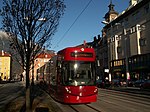
In Austria, Gmunden, Graz, Innsbruck, Linz and Vienna all have tramway systems. With 173.4 km of track, Vienna's network is one of the largest in the world. The cars have been constantly modernised over the years and many are now ultra low-floored. Many of the Austrian tramlines have been in constant operation since they were first opened. Vienna started with horse trams in 1865 and electrification followed in 1897. Graz had horse trams in 1878 and electric cars in 1898 while Linz goes back to 1880 with electrification in 1897. The Gmunden Tramway, only 2.3 km long, is currently one of the shortest in the world, and with gradients of up to 9.6%, it is also one of the steepest and has become a popular tourist attraction. Innsbruck, which traditionally used second-hand trams from other cities, replaced its whole fleet with 32 Bombardier low-floor cars in Summer 2009. The Pöstlingbergbahn, in Linz, an unusual "mountain tramway", has a gradient of 10.6%, which makes it one of the world's steepest gradients on a surviving adhesion-only railway. The tramway now reaches the city centre via the tracks of the urban tram system.
Belarus

There are four tram systems in Belarus currently: Minsk, Mazyr, Novopolotsk and Vitebsk.
Belgium

In Belgium an extensive prewar system of tram-like local railways called Vicinal or Buurtspoorweg lines used to exist, which had a greater total route kilometre length than the main-line railway system. The only survivors of the Vicinal system are the Kusttram, the longest tram line in the world, which almost reaches France at one end of the line and the Netherlands at the other, and two short lines that form part of the Charleroi Pre-metro.
Urban tram networks exist in Antwerp, Ghent and Brussels, and are gradually being extended. In Liège a new tram line is currently under construction.
Bosnia and Herzegovina

The electric tram started in Sarajevo in 1895.
Several trams were badly damaged during the Bosnian war. Several European countries donated out of use trams to Sarajevo in the years after the war.
Recently, more modern vehicles have arrived to upgrade and expand the fleet.
Bulgaria
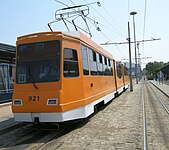
Sofia is the only city that currently has a tram system. It had its first horse-drawn tram in operation in 1898. On 1 January 1901 the electric tram system was inaugurated and had 25 cars and 10 carriages and the total length of the lines was 25 km. Currently Sofia's extensive tram network consists of 15 routes, 3 of which are operated on the standard gauge of 1435mm, while the others use a narrow gauge of 1009mm. Due to the construction of the Sofia Metro there were some closures and retracing, but the system continues to be one of the largest in Europe. According to the official website, as of 2006 there are 308 km of track, with 190 trams in service on any given weekday.
Croatia

| This section does not cite any sources. Please help improve this section by adding citations to reliable sources. Unsourced material may be challenged and removed. (June 2019) (Learn how and when to remove this message) |
Zagreb has had a tram service since 5 September 1891; it is now an extensive tram network with 15 day lines and 4 night lines covering over 116 km (72 mi) of tracks through 255 stations. ZET, the major transit authority in Zagreb, ordered 210 new, 100% low-floor trams from Croatian consortium Crotram. As of 2010, all of these locally produced, low-floor Crotram trams have been delivered, with a mixture of vehicle types in operation, including Czech Tatra Cars and various locally produced trams. Zagreb is one of the few tram networks in the world where most of the operations run at the kerb.
The only other Croatian city with trams still in operation is Osijek. The first tram route commenced in 1884 (connecting the railway station and city square) and trams have been running since. Between 2006 and 2007, the trams were refurbished and modernised. Two lines presently exist, with another two extensions planned, doubling the network length.
Dubrovnik, Opatija, Pula, Rijeka and Velika Gorica previously also operated trams.
Czech Republic
| This section does not cite any sources. Please help improve this section by adding citations to reliable sources. Unsourced material may be challenged and removed. (June 2019) (Learn how and when to remove this message) |

The Czech Republic is well known for its extensive tram infrastructure, with trams often being present even in small cities. The largest network is in Prague, with 150,3 kilometres of track and 26 day lines, 9 night lines and 2 historical lines. Other cities with tram systems are Brno, Ostrava, Plzeň, Olomouc, Most and Litvínov (common network), Liberec (including intercity line to Jablonec). Tram networks in nine other cities were closed down mainly during the 1960s and replaced with trolleybuses or buses.
Before changes in 1989, ČKD Tatra in Prague was the largest tram producer in the world, mainly exporting its trams to Soviet Bloc countries. Production was definitely stopped in 2001, after ČKD was sold to Siemens AG. The tradition of tram production is continuing with Škoda Transportation, Inekon and PRAGOIMEX.
Denmark

In Aarhus, Denmark the Aarhus Letbane a new tramway is combined with converted local railways, operating since December 2017.
In Odense, Denmark the Odense Letbane a new tramway, operating since 28 May 2022.
In Copenhagen, Denmark construction has started on a new tramway, expected to start operation in 2025.
Estonia
| This section does not cite any sources. Please help improve this section by adding citations to reliable sources. Unsourced material may be challenged and removed. (June 2019) (Learn how and when to remove this message) |
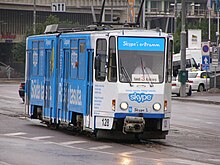
In Estonia, trams are used only in the capital, Tallinn. There has been a growing tram network in Tallinn since 1888, when traffic was started by horse-powered trams. The first line was electrified on 28 October 1925. Estonian-built electric trams were also used, with some gas-powered trams having been used in the 1920s and 1930s. The last part of the system to be electrified was the spur to Kopli in 1951, which was also converted to double track at the time, and was connected to the rest of the network in 1953.
From 1955 to 1988, German-built trams were used. The first Czechoslovakian-built tram arrived in 1973. In 2007, 56 Tatra KT4SUs, 12 KTNF6s (rebuilt KT4SUs) and 23 second-hand KT4Ds trams were in use. There are four lines, with total length of tramlines 39 km. Plans have been in the works since the late 1970s to open a light rail line from one of the suburbs, Lasnamäe, to the city centre.
In 2017, an extension was opened to Tallinn Airport. This is the first extension to the network since 1955, when the stretch to Ülemiste district was lengthened.
The track and electrical systems have also undergone major work to enable the system to accommodate 20 new vehicles delivered by CAF in 2016.
Finland

In Finland, there have been four cities with trams: Helsinki, Turku, Viipuri and Tampere. Of the three older systems only Helsinki has retained its tram network. The system has operated continuously since 1891 and it was fully electrified by 1901. Currently there are 10 tram lines on 89.5 kilometres of track. Around 200,000 passengers use the tram network each weekday and within the inner city of Helsinki trams have established a position as the main form of public transport. The network is being actively developed, with a new line opened in 2008 and more lines planned to connect new residential areas to be built in 2009–2015. In 2009, the city invited bids for manufacturers to produce 40 new low-floor trams, with an option for further 50 available.
The City of Tampere begun construction of a tram network in early 2017, with phase 1 from the city centre to Hervanta, and the University Hospital. The first phase of the tram system was opened in 2021. Construction of phase 2, from the city centre to Lentävänniemi in the west, begun in 2021 and is expected to be completed in 2024.
The cities of Oulu and Turku have started the planning of tram networks. Turku has accepted The Light Rail Network of Turku's principal plan as obeyed normatively. Even though Oulu's vice mayor rejected the idea, the city included it in The Zoning Scheme of New Oulu as "normative" and "necessary".
France
Main article: Trams in France See also: List of town tramway systems in France
Despite the closure of most of France's tram systems in previous decades, a rapidly growing number of France's major cities boast new tram networks, including Paris (the largest French network), Lyon, Marseille, Nantes, Strasbourg, Grenoble, Montpellier, Saint-Étienne and Besançon. Since the 1990s, tram systems have been introduced, or expanded, in twenty-seven towns and cities. Many experiments, such as ground level power supply in Bordeaux, avoiding the need for overhead line equipment, or trolleybus-tram-BRT hybrids in Nancy and Caen with Bombardier Guided Light Transit. Smaller cities like Avignon are now running tram lines too.
Germany
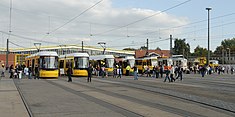
Tramways in Germany served as the primary means of urban transport until the early 1960s when they were systematically replaced by buses. Tramways begun to reappear in the 1980s, before once again becoming a modern means of public transport in the 1990s. Popular notions of fashion have been used by scholars to explain this cycle of acceptance, rejection and restoration.
Germany (where tramways are called Straßenbahn, meaning street railway) is notable for its large numbers of extensive tram systems, although even in this country many systems were closed after the Second World War, such as the tramway in Hamburg which last ran in 1978. Following the renaissance of trams in France and positive experience with tram-train and similar concepts (e.g. the Karlsruhe model), most German tramways are expanding, including new systems in cities that had previously abandoned them or entirely new systems in cities without any tram history.
Light rail in Germany
Further information: StadtbahnStadtbahn, literally city railway in the German language, is the term for light rail in Germany and is the predecessor of the North American light rail. Most German light rail systems were started in the 1960s and 1970s with the intention of establishing full-scale underground, or U-Bahn (short for Untergrundbahn) systems. By the 1980s virtually all cities had abandoned these plans due to the high costs of converting tramways, and the most common systems are a mixture of tramway-like operations in suburban areas, with U-Bahn style operation, featuring underground stations, in the city centre areas.
Greece
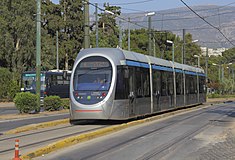
Trams were the main mode of mass transportation in Athens, Thessaloniki, Patras, Volos, Kalamata and Piraeus before World War II but were ripped out due to the cars and busses rapidly rising popularity.
The first trams in Athens began operating in 1882. They were light vehicles drawn by three horses running on an extensive network throughout the city centre and a line reaching the suburb of Faliro. After the German occupation, the tramways began to decline, with lines gradually abandoned and replaced by trolleybuses, considered more appropriate and agile for the urban environment at that time. It is frequently mentioned somehow poetically that "The last bell of the Athens Tram rang on the midnight of October 16, 1960". The tram had been a trademark of Athens until that date, and it is still viewed nostalgically. One tram line was left in Perama, which remained in operation until April 1977. A modern tram line was installed for the 2004 Summer Olympics, with vehicles designed by the famous Ferrari designer Sergio Pininfarina. There are three routes and 24 km of tramlines, running from Syntagma Square to Eden Station, and from Peace & Friendship Stadium in Piraeus to Glyfada along the coast. Routes were extended by 0.7 km from Glyfada to Voula in 2007, and was expanded 2.5 km further from Peace & Friendship Stadium to Piraeus centre in 2021.
Hungary
Main article: List of town tramway systems in HungaryThe Hungarian cities of Budapest, Debrecen, Hódmezővásárhely, Miskolc and Szeged currently have tramways. The Budapest network, at 149 km, is the backbone of the capital's transit system and is by far the most extensive in the country.
Historically, Hungary has had tramways in Sopron until 1923, Pécs until 1960, Nyíregyháza until 1969 and Szombathely until 1974.
Ireland
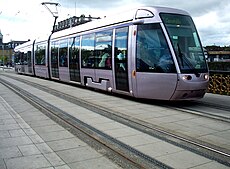
Replacing a once-extensive network of Dublin tramways which closed in 1949, in 2004 the Irish capital Dublin opened the first two lines of a new light-rail system known as Luas, Irish for "speed". It features on-street running in the city centre, but is considered a light-rail system as it runs along a dedicated right-of-way for much of its suburban route. Two light-metro lines fully segregated from traffic were planned to be built by 2014, but were cancelled due to the economic downturn.
Plans also exist for light-rail systems in the cities of Cork, which had a modest system until the early 20th century, and Galway. In January 2007, the Green Party promised that, if it formed part of the next government in 2007, it would have light rail systems built in those two cities. A smaller campaign was also ongoing for the construction of a light rail system in Limerick.
Italy
See also: List of town tramway systems in Italy| This section does not cite any sources. Please help improve this section by adding citations to reliable sources. Unsourced material may be challenged and removed. (June 2019) (Learn how and when to remove this message) |

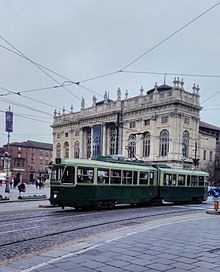
Trams in Italy have been in constant operation since the mid-19th century. The first horse-drawn line opened in Turin in 1871, whilst the first electric line was opened in 1893 in Milan.
Current tramways in Italy are:
- Bergamo – since 2009 with 1 suburban light rail line running over 12.5 km of track, operated by TEB Bergamo; a second 11.5 km suburban line in costruction, as of 2024, and is scheduled to open in 2026.
- Cagliari – since 2008 with 2 suburban light rail lines running over 12 km of track, operated by ARST.
- Florence – since 2010 with 2 urban lines running over16.8 km of track, operated by a joint venture GEST between municipal transport company ATAF Firenze and RATP Paris.
- Messina – since 2003 with 1 urban line running over 7.7 km of track, operated by ATM Messina.
- Mestre/Venice – since 2010 with 1 urban line running over 7.7 km of track, operated by ACTV.
- Milan – since 1881 with 17 urban lines, running over 181 km of track, operated by ATM; two interurban lines were closed since 2010. Although in 2023, renovation and reconstruction works started on one of them.
- Naples – since 1875 with 3 urban lines running over 11.8 km of track, operated by ANM Napoli.
- Padua – since 2007 with 1 Translohr urban line running over 10.3 km of track, operated by APS Padova.
- Palermo – since 2015 with 4 urban lines.
- Rome – since 1877 with 6 urban lines running over 40 km of track, operated by ATAC Roma.
- Sassari – since 2006 with 1 tram-train line running over 4.3 km of track, operated by ARST.
- Trieste – since 1902 with 1 hybrid tramway-funicular railway line running over 5.2 km of track, operated by Trieste Trasporti.
- Turin – since 1871 with 9 urban lines running over 84 km of track, operated by GTT Torino.
Latvia

There are currently three tram systems in Latvia, in Riga, Daugavpils and Liepāja.
Luxembourg
Main article: Trams in LuxembourgTrams began serving Luxembourg City in 1875, and in Esch-sur-Alzette in 1927. First generation trams in the country ended with the closure of the Esch-sur-Alzette network in 1956, and the Luxembourg City network in 1964. A second generation of trams began service in December 2017, along a new route that will, by 2021, run from Luxembourg Airport to the Cloche d'Or business district.
Malta

A tram service was inaugurated in Malta on 23 February 1905, linking the capital Valletta with Floriana, Ħamrun, Birkirkara, the Three Cities, Qormi and Żebbuġ. The service competed with the Malta Railway and later the Malta buses. Service eventually ceased on 15 December 1929.
The Ministry of Transport has considered the reintroduction of trams in Malta.
Netherlands
Further information on Transportation in the Netherlands: Transportation in the Netherlands § Tram / light rail See also: List of town tramway systems in the NetherlandsIn the Netherlands many local light railways were referred to as trams, even where the steam locomotives did not have enclosed motion. Today, extensive tram networks exist in:
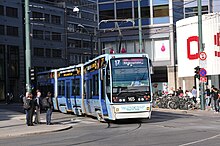
Norway
There are three tramways (Template:Lang-no) in Norway; the Oslo Tramway that operates as a hybrid between a light rail and a street tram with six lines, and the suburban line of Trondheim Tramway, the Gråkall Line. The Bergen Tramway was closed in 1965, but the new Bergen Light Rail opened in 2010.
Poland
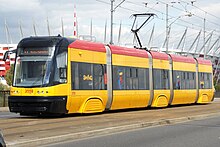
| This section does not cite any sources. Please help improve this section by adding citations to reliable sources. Unsourced material may be challenged and removed. (June 2019) (Learn how and when to remove this message) |
Trams currently operate in 15 Polish cities/metropolises: Bydgoszcz, Częstochowa, Elbląg, Gdańsk, Gorzów Wielkopolski, Grudziądz, Katowice/Metropolis GZM, Kraków, Łódź, Olsztyn , Poznań, Szczecin, Toruń, Warsaw and Wrocław. The largest system is Silesian Interurbans in Metropolis GZM with 255 km of track and 35 lines, followed by Warsaw with 150 km of route length and 34 lines and Łódź with 124 km of route length and 28 lines. A system in Płock was planned but the construction was postponed indefinitely in 2011.
Portugal

The Lisbon tramway network has been managed by the Companhia Carris de Ferro de Lisboa, or Carris for short, for over a century. Since 1995, the fleet includes authentic vintage cars, units made from vintage bodies powered by modern engines, and fully modern articulated trams.
In Porto, a tram network has been in operation since 12 September 1895, making it the first electric tramway in the Iberian Peninsula. Many routes closed in the 1970s and 1980s, but one survived and some closed sections have reopened in the 2000s, and four routes are currently in operation.
A heritage tram line operates seasonally in Sintra. Reductions in the network's original service started in 1954, until closure in 1975. It was re-opened in 1980 using a section of the former line and surviving trams.
Almada has a light rail network, the Metro Sul do Tejo, which opened in 2007, following two decades of planning. Extensions to Seixal and Barreiro are currently planned.
Romania
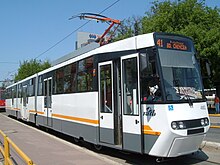
There are currently 10 tram systems in Romania, in Arad, Brăila, Bucharest, Cluj-Napoca, Craiova, Galaţi, Iaşi, Oradea, Ploieşti, Timișoara.
Serbia

Belgrade has a large tram network with 12 lines on 127.3 km of track. The system is operated with around 250 units and with ČKD Tatra KT4 and Duewag Be 4/6 trams. The first horse-drawn tram line was introduced in October 1892 and the first electric one in 1894. There are long-term plans to build a new track to the Mirijevo neighbourhood, in the east of the city.
Previously the cities of Niš, Novi Sad, and Subotica also had tram networks, but these closed in Novi Sad and Niš in the 1950s, and in Subotica in 1974.
Slovakia
There are tram networks in both Bratislava and Košice.
The first trams in Bratislava started operation in 1895, and there are currently 5 lines in service with a track length of 41.5 km. A newest tram line was built across the river Danube to the Petrzalka suburb on the right bank. There are multiple plans for expanding the network, but funding is currently unclear.
Košice started operating trams in 1914, after wagons pulled by horses and a steam tramway. Trams currently run over 34 km of tracks and run on 7 lines within the city and 8 fast tram lines to U. S. Steel Košice.
Spain
Main article: Trams in Spain See also: List of town tramway systems in Spain and Transport in Spain § Cities with metro/light rail systems
In Spain, modern tram networks have been opened in Alicante, Barcelona (Trambaix and Trambesòs), Bilbao, Madrid, Murcia, Parla, Santa Cruz de Tenerife, Seville, Valencia, Vélez-Málaga, Vitoria-Gasteiz and Zaragoza. Jaén had built a tram network in 2011, but it only operated for a short period.
Sweden
| This section does not cite any sources. Please help improve this section by adding citations to reliable sources. Unsourced material may be challenged and removed. (June 2019) (Learn how and when to remove this message) |

The most extensive network in Sweden is in Gothenburg with a total track length of 90 km double track. Gothenburg started with the Horse Tramway in 1879 and over the years the tramway has expanded into the Nordic region's largest tramway system.
Stockholm had horse-drawn trams from 1877; however, the large tram system began to be abandoned and removed in 1957, with the last tram running in September 1967. Presently Stockholm has four lines on three non-connected systems owned by Storstockholms Lokaltrafik: Spårväg City; Lidingöbanan; Nockebybanan and Tvärbanan. There are plans for future extensions and two projects are in active development.
Norrköping has an 18.7 km tram network consisting of two radial lines, which was extended by 5 kilometres in 2006–2011.
Lund inaugurated its first ever tram line on the 12th of December 2020. At a length of 5.5 kilometers, it connects Lund Central Station with the new urban development at Brunnshög and the research facilities MAX IV and ESS.
A single-track heritage line has operated in Malmö since 1987, after the last "real" tram line closed in 1973. City officials decided in October 2008 that the city should have at least one light rail line operating before 2020, and up to six lines after that.
A combined tramway museum and heritage tramway is located at Malmköping, Södermanland County, maintained by Svenska Spårvägssällskapet, the Swedish Tramway Society.
Switzerland
See also: List of town tramway systems in Switzerland
The first tram in Switzerland began operations in 1862 in Geneva. The tram, which was initially horse-drawn, got converted to steam in 1877. In 1888 the second electric tram system in the world was inaugurated in Vevey, linking the city to Montreux and Château de Chillon. By 1923, a total of 29 towns and cities in the country operated tram networks, and at 170 km in extension and operating beyond the country's borders into France, Geneva's tram network became Europe's largest system
After WW2 and the introduction of buses and trolleybuses, many of the networks shrunk. Geneva lost all but one of its lines, and some cities closed their trams, including Fribourg, Lausanne, Lugano, Biel/Bienne, Luzern, Vevey, Montreux, St. Gallen, Schaffhausen, or Zug.
However, Switzerland is remarkable in that a few major cities kept their networks mostly intact until today. For example, although some of the tram lines extending beyond the city of Zurich closed down, the vast majority of lines within the city did not suffer any closures. Similarly, Bern and Basel kept most of their tram lines intact.
Because, with the exception of Geneva and Lausanne, the country's major cities have not lost their tram systems, Switzerland has not witnessed a major re-construction of trams as happened in the rest of Europe in the decades following the 1990s. The major exception is Geneva, where the system has been growing back again from the one line and 8 km that was left out of its original network, to 5 lines and 36 km. By the end of 2019, with the opening of line 17, the network had once again extended over the border to the French city of Annemasse, with planned future extensions to over 50 km by 2026.
Turkey
Main article: Transport in Turkey See also: IETT
The first tram line in Istanbul was constructed by Konstantin Karapano Efendi, and started operating on 31 July 1871 between the districts of Azapkapi and Ortaköy. In 1869, the tram company "Dersaadet Tramvay Şirketi" was established. 430 horses were used to draw the 45 carriages, including 15 summer-type and some double-deckers, on meter gauge track. In 1912, the horse-drawn tram had to cease to operate for one year because the Ministry of Defence sent all the horses to the front during the Balkan War. The tram network was electrified by overhead contact wire on 2 February 1914. The tram began to run on the Anatolian part of Istanbul on 8 June 1928 between Üsküdar and Kisikli. By the 1950s, the length of the tram lines reached 130 km. Trams were in service on the European part until 12 August 1961 and on the Anatolian part until 14 November 1966.
Heritage trams returned to Istiklal Caddesi in 1990 and in Moda in 2003. Modern trams began service on the European side in 1992 and have since been expanded. The latest addition to the system, as of 2021 was the T5 line running along the Golden Horn.
Istanbul is the only city in European Turkey with operating trams. In Anatolia, there are operating trams in Adana, Antalya, Bursa, Eskişehir, Gaziantep, Kayseri, Kocaeli, Konya, Samsun and İzmir.
United Kingdom and Crown dependencies
Main article: Transport in the United Kingdom § Trams and light rail Main article: Transport in the Isle of Man See also: List of town tramway systems in the United Kingdom
Until 1935 there was a large and comprehensive network of tram systems. For example, one could travel by tram across northwest England, from Liverpool to Ashton-under-Lyne (approx. 43 miles) using connecting systems. Most UK systems were municipally owned. These had often been inherited from private sector operators, who had been granted limited-term leases and did not maintain their networks beyond bare necessities as the time for a forced handover approached. When councils acquired these dilapidated systems, it was almost always cheaper to replace them with buses. The 1931 Royal Commission on traffic argued that trams held up cars.
There was some public reaction against tramway abandonment, but seemingly less than the similarly unsuccessful reaction against Beeching cuts in the 1960s. Some people, particularly motorists, welcomed the removal of trams, which were perceived as obstructing the highway. Not all passengers transferred to replacement buses, and car ownership continued to increase.
Britain's tram systems were mainly dismantled between 1920 and 1960, and after the closure of Glasgow's once extensive GCT network in 1962, only Blackpool's trams survived, although the Great Orme Tramway funicular line continued to operate up the Great Orme in Llandudno.
Since the 1990s, a second generation of tram networks have been built and have started operating in Manchester in 1992, Sheffield in 1994, the West Midlands in 1999, South London in 2000, Nottingham in 2004 and Edinburgh in 2014, whilst the original trams in Blackpool were upgraded to second generation vehicles in 2012.
There have been numerous other proposals for tramways in other cities and extensions to existing systems the UK, whilst the system in the West Midlands is currently having extensions built.
On the Isle of Man, electric tram cars have run almost continuously since the late 19th century (albeit mainly as summer tourist attractions) on the Manx Electric Railway (Douglas to Ramsey) and the Snaefell Mountain Railway (Laxey to Snaefell summit), as well as horse trams along Douglas Promenade.
Former USSR/Russia and CIS
| This section does not cite any sources. Please help improve this section by adding citations to reliable sources. Unsourced material may be challenged and removed. (June 2019) (Learn how and when to remove this message) |

In many cities of Russia, Ukraine, Armenia, Georgia, Azerbaijan and Uzbekistan tramways have been facing difficulties since the disintegration of the USSR. Tramways of Shakhty, Arkhangelsk, Astrakhan, Grozny, Tbilisi, Baku, Yerevan, Almaty, Sumqayit, Gandja and Tashkent have been abandoned. Some tramway systems have suffered extensive closures of vital parts of network (including Saint Petersburg, Moscow, Kyiv) and some are facing threats of closures (Nizhniy Novgorod) or even total abandonment (Voronezh).
The tramway network in Saint Petersburg is the largest in Europe, and was once the second-largest in the world, surpassed only by Pacific Electric's 160 km network in Los Angeles. The network in Melbourne, Australia, is now larger.
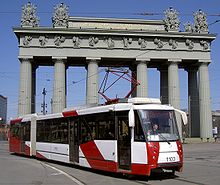
See also
- List of light-rail and tramway systems in Europe
- List of town tramway systems in Europe
- Bucharest Articulated Tramcar
- Tram
- Light rail
References
- Barbara Schmucki, "The machine in the city: public appropriation of the tramway in Britain and Germany, 1870–1915." Journal of Urban History 38.6 (2012): 1060-1093.
- Sturm, Edo (12 February 2008). "Steden willen weer terug naar de tram". Trouw (in Dutch). Netherlands. Retrieved 13 August 2008.
- Docherty, Iain; Shaw, Jon (2003). A New Deal for Transport?: The UK's Struggle with the Sustainable Transport Agenda. Blackwell Publishing. p. 138. ISBN 978-1-4051-0631-3.
- "French rediscover love for streetcars". UPI. Paris. 18 July 2008. Retrieved 13 August 2008.
- Ashton, Kimberly (5 December 2007). "Tram service to expand". Prague Post. Archived from the original on 7 October 2008. Retrieved 13 August 2008.
- Lissenberg, Ferry (21 October 2017). "[LU / Expert] The tram returns to Luxembourg; an update about the Luxtram project". Railcolor. Retrieved 4 April 2019.
- "Bus and rail in Austria by Manfred Novy, Project Director, UITP Office 2009" (PDF). Archived from the original (PDF) on 6 March 2009. Retrieved 2 March 2009.
- Wolfgang Kaiser: Straßenbahnen in Österreich. GeraMond Verlag, 2004 ISBN 3-7654-7198-4
- Taplin, Michael; and Russell, Michael (2002). Trams in Western Europe, p. 8. Harrow Weald, Middlesex (UK): Capital Transport Publishing. ISBN 1-85414-265-8.
- Verein pro Gemundner Strassenbahn. Retrieved 2 March 2009.
- "Press release from Bombardier, October 2007" (PDF). Retrieved 2 March 2009. Archived 6 March 2009 at the Wayback Machine
- Buckley, Richard (2000). Tramways and Light Railways of Switzerland and Austria (2nd edition), p. 129/139. Gloucester, UK: Light Rail Transit Association. ISBN 0-948106-27-1.
- Radiosarajevo.ba. "Neven Anđelić: O mitu da je Sarajevo imalo prvi tramvaj u Evropi". Radio Sarajevo. Retrieved 20 November 2019.
- "History of trams in Sofia (in Bulgarian)". Centre for Urban Transport. Retrieved 1 January 2013.
- "Letbanen åbner til Odder og Lisbjergskolen lørdag 25. august". www.letbanen.dk.
- "Kom til åbningsfest for Odense Letbane lørdag d. 28. maj. Odense has previously had trams. From 1911 till 1952 one line operated between the zoo near Fruens Bøge and Hunderup Skov". www.odense.dk (in Danish). Retrieved 8 June 2022.
- "Tidsplan". Hovedstadens Letbane (in Danish). Retrieved 8 June 2022.
- "The Tampere Tramway Story". 16 March 2022.
- rjlahtin (24 March 2015). "Raitiotie". turku.fi.
- "Kuntalehti: Oulun raitiovaunut eivät ole realismia, sanoo Matinheikki". kaleva.fi.
- Uuden Oulun Yleiskaava – Liitteet 10-13 (PDF) [The Zoning Scheme of New Oulu – attachments 10-13] (in Finnish). Oulun Kaupunki. 15 January 2016. p. 3.
- "Grand Avignon tram line opened". 21 October 2019.
- "Η ιστορία του Τραμ της Θεσσαλονίκης". Thessalonikiartsandculture.gr (in Greek). Retrieved 9 August 2023.
- npress (18 May 2016). "Το τραμ της Πάτρας (1902-1918) - Ένα μοναδικό αφιέρωμα". npress.gr (in Greek). Retrieved 9 August 2023.
- "Αποτελέσματα Αναζήτησης". www.evonymos.org. Retrieved 9 August 2023.
- "Green Party commits to new light rail projects". Archived from the original on 27 September 2007. Retrieved 23 June 2019.
- "Why have the Greens forgotten about Limerick?". Retrieved 23 June 2019.
- "Linea T2 - Home". www.t2vallebrembana.it (in Italian). Retrieved 30 August 2024.
- Montella, Marco (19 April 2024). "Milano | Mobilità – Metrotranvia Milano-Desio-Seregno: aprile 2024". Urbanfile (in Italian). Retrieved 30 August 2024.
- ^ "Tram returns to city after 50 years". Delano. 12 July 2017. Retrieved 30 November 2019.
- "Next generation tramways: Luxembourg". Tramways & Urban Transit. October 2019.
- Azzopardi, Nicholas. "Brief History". maltarailway.com. Retrieved 22 October 2015.
- "'The Story Of the Malta Buses 1931-2011': A must-have publication". The Malta Independent. 29 July 2011. Retrieved 22 October 2015.
- Simmons, David (5 December 2008). "The Potential For Introducing A Tram Service In Malta" (PDF). Ministry of Transport. Retrieved 22 October 2015.
- King, B. R.; and Price, J. H. (1995). The Tramways of Portugal (4th edition), p. 41. London: Light Rail Transit Association. ISBN 0-948106-19-0.
- Lennox Docherty, Bob (September 2008). "Iron whispers in the Pinewoods of Sintra". Tramways & Urban Transit, pp. 364–365. LRTA Publishing.
- Kavacký, Matej (1 January 2010). "História verejnej dopravy v Bratislave pred rokom 1895". imhd.sk (in Slovak). Retrieved 1 September 2021.
- Kavacký, Matej (1 January 2010). "História bratislavskej MHD v rokoch 2016 až 2020". imhd.sk (in Slovak). Retrieved 1 September 2021.
- Baran, Sebastián (14 November 2013). "História MHD v Košiciach: Na počiatku električky (1909 - 1918)". imhd.sk (in Slovak). Retrieved 1 September 2021.
- "Cestovné poriadky". dpmk.sk (in Slovak). DPMK. 1 June 2021. Retrieved 1 September 2021.
- "Spårväg Lund C - ESS". www.lund.se.
- "50 km pour le réseau de tramway | Grand Genève". Grand Genève. Retrieved 23 February 2020.
- "Développement du réseau de tramway". www.ge.ch (in French). République et canton de Genève. Archived from the original on 23 February 2020. Retrieved 26 May 2023.
- "İETT - Sayfa Bulunamadı". iett.gov.tr. Retrieved 15 July 2018.
- London Trams and Trolleybuses Archived 23 March 2010 at the Wayback Machine. Retrieved 13 February 2009.
- The Campaign To Save the London Trams 1946–1952 from the Collected Papers of Alan John Watkins. Retrieved 13 February 2009.
| Trams in Europe | |
|---|---|
| Sovereign states |
|
| States with limited recognition | |
| Dependencies and other entities | |